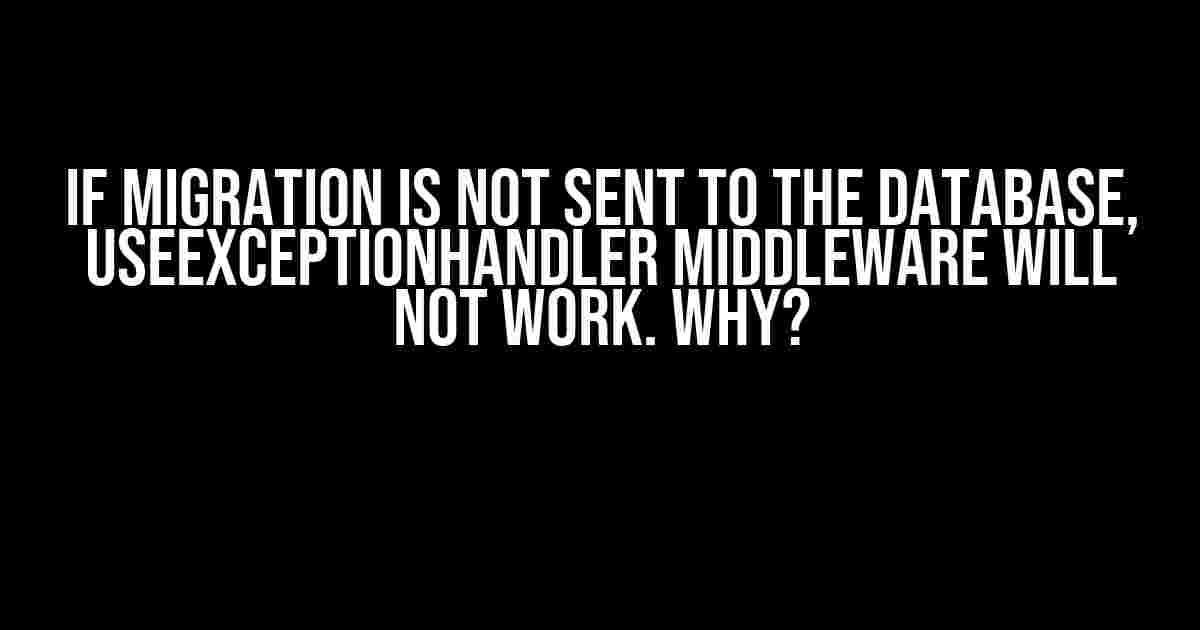Have you ever encountered an issue where your UseExceptionHandler middleware is not catching exceptions in your ASP.NET Core application? You’ve set it up correctly, but it’s just not working as expected. There’s a good chance that the culprit behind this issue is not sending migrations to the database. But why does this affect the middleware’s ability to catch exceptions?
Understanding the Role of Migrations in ASP.NET Core
In ASP.NET Core, migrations are used to manage changes to the database schema. When you make changes to your models or database schema, you need to create a new migration to apply those changes to the database. This ensures that the database is always in sync with your application’s code.
Migrations are essential in ASP.NET Core because they help you to:
- Track changes to the database schema
- Apply changes to the database schema
- Roll back changes to the database schema if needed
The Relationship Between Migrations and UseExceptionHandler Middleware
So, how do migrations affect the UseExceptionHandler middleware? It’s crucial to understand that the middleware relies on the database to store exception data. When an exception occurs in your application, the middleware catches it and stores the exception data in the database.
However, if migrations are not sent to the database, the database schema will not be updated to include the necessary tables and columns required for exception data storage. As a result, the middleware will not be able to store exception data, and it will not work as expected.
How to Send Migrations to the Database
To send migrations to the database, you need to follow these steps:
- Open the terminal or command prompt in your project directory
- Run the command
dotnet ef migrations add InitialCreateto create a new migration - Run the command
dotnet ef database updateto apply the migration to the database
Once you’ve applied the migration to the database, the database schema will be updated to include the necessary tables and columns for exception data storage.
Troubleshooting UseExceptionHandler Middleware Issues
If you’re experiencing issues with the UseExceptionHandler middleware, here are some things to check:
- Make sure migrations are sent to the database
- Verify that the database schema includes the necessary tables and columns for exception data storage
- Check that the middleware is correctly configured in the Startup.cs file
- Verify that the exception is being thrown and caught by the middleware
Common Errors and Solutions
Here are some common errors you might encounter when using the UseExceptionHandler middleware, along with their solutions:
| Error | Solution |
|---|---|
| Error: “Cannot find table ‘AspNetCoreErrorLogs’ in the database.” | Solution: Apply the migration to the database using the command dotnet ef database update. |
| Error: “Exception data is not being stored in the database.” | Solution: Verify that the middleware is correctly configured in the Startup.cs file and that the database schema includes the necessary tables and columns for exception data storage. |
| Error: “UseExceptionHandler middleware is not catching exceptions.” | Solution: Verify that the exception is being thrown and caught by the middleware. Check that the middleware is correctly configured in the Startup.cs file. |
Conclusion
In conclusion, if migration is not sent to the database, the UseExceptionHandler middleware will not work as expected. This is because the middleware relies on the database to store exception data, and the database schema must be updated to include the necessary tables and columns for exception data storage.
By following the steps outlined in this article, you should be able to troubleshoot and resolve issues with the UseExceptionHandler middleware. Remember to always send migrations to the database and verify that the database schema includes the necessary tables and columns for exception data storage.
<code>
// Example code for configuring the UseExceptionHandler middleware in the Startup.cs file
public void Configure(IApplicationBuilder app, IWebHostEnvironment env)
{
app.UseExceptionHandler("/Home/Error");
// Other middleware configurations...
}
</code>
By understanding the relationship between migrations and the UseExceptionHandler middleware, you can ensure that your ASP.NET Core application is correctly configured to handle exceptions and provide a better user experience.
Frequently Asked Question
Get answers to the most pressing questions about UseExceptionHandler Middleware and database migration!
Why does UseExceptionHandler Middleware rely on database migration?
UseExceptionHandler Middleware uses the database to store error details, which means it needs the migration to be sent to the database to function correctly. Without migration, the middleware won’t have a place to store error information, rendering it useless!
What happens if migration is not sent to the database?
If migration is not sent to the database, UseExceptionHandler Middleware will not work as expected. You won’t be able to log errors or retrieve error information, making it difficult to troubleshoot and debug your application!
Can I still use UseExceptionHandler Middleware without database migration?
Technically, yes, but it won’t be of much use! Without database migration, UseExceptionHandler Middleware won’t be able to store or retrieve error information, making it ineffective. It’s like having a fire alarm without a connection to the fire station!
What are the consequences of not sending migration to the database?
Failing to send migration to the database can lead to incomplete or inaccurate error logging, making it challenging to identify and fix issues. This can result in prolonged downtime, frustrated users, and a potential loss of revenue!
How can I ensure UseExceptionHandler Middleware works correctly?
To ensure UseExceptionHandler Middleware works correctly, make sure to send the migration to the database and configure the middleware properly. This will enable you to log and retrieve error information effectively, helping you build a more robust and reliable application!
